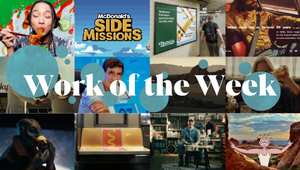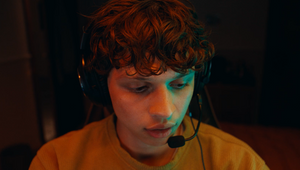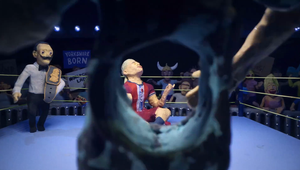
“Give Them the Truth and You’ll Make Them Feel Something”

Enhancing the emotion of moving image is fundamental to what we do at CHEAT. Behind the scenes we’re invested in innovation to do just that. Years of technical research and development, colour science and film emulation, mean we are constantly finding new ways to deepen our impact on an emotive level in this medium. This is why we’re sponsoring LBB’s 'Emotion in Advertising' strand, exploring the theme through interviews with experts who share our passion.
LBB’s Alex Reeves catches up with TBWA\Media Arts Lab creative director Jo Forel to hear about the ups and downs of her year-long round-the-world trip, why working at Mother in the early years freaked her out and how a team based in bedrooms and kitchens around the country made Britain proud of its creative heritage.
LBB> You studied design and then ended up making a career as a writer. How did that shift happen?
Jo> Well, I went to Central Saint Martins. And in an art school full of crazy talented visual people, not many of them wanted to be the copywriter. I could spell, had always loved words and spent my bookworm childhood nicknamed Matilda. So I guess I saw a gap in the market. Also, I was crap at typography.
LBB> Coming up through Mother, Saatchi's and Droga5, what were the biggest realisations or lessons that you draw on in your work now?
Jo> Mother was the big one in terms of influence. It was my first job out of college and it gave me an incredible (if exhausting) crash course in advertising. Their way of doing business, back in the days of St John street and sleeping in the office caravan, really freaked me out at first. There was no fear whatsoever: if a client only wanted to make boring work, they fired the client. If a junior team had never been to a client meeting before, they were still presenting their idea. If the work was scary or uncomfortable or right on the edge of acceptable, even better. However, the most important thing that Mother taught me was to find the truth. And I think that the truth is the biggest emotional punch you can deliver. Give the world an invented advertising conceit and they’ll see right through you. Give them the truth and you’ll make them feel something.
LBB> We need to hear about your adventure around the world a few years back. What's the story?
Jo> My husband Lori and I had always travelled, but never done a round the world trip. I was pregnant with our son, and we figured maternity leave could do with some excitement. Our daughter was four, and we’d figured out we could skip reception as long as we taught her for the summer term. So we bought the tickets and flew to Kathmandu with some bags, a phonics teaching pack and a six month old strapped to my front.
Over the next year, we travelled through Nepal, India, Sri Lanka, Thailand, Vietnam, Cambodia, Singapore, Chile, Mexico, Cuba, France, Switzerland and Italy. We ate everything. We talked to everybody. We researched personal projects. River was weaned on Thai street food. Olivia learned to read in a Sri Lankan jungle. We introduced our family to new perspectives and cultures and people and tastes. Our blog is at www.littlewander.io if you fancy some stories.
LBB> That must have been an emotional experience in practically every way possible. How has it impacted on your work as a creative?
Jo> It really was. There were lows, when the money was tight or the weather was rough or when Lori exploded his knee on a trampoline and had major surgery so we all had to live in Chiang Mai for months. But the highs were worth it all. River spent his first birthday in Hoi An on a boat where we made wishes for him and floated them out onto the water. He didn’t give a damn about a fancy party.
We learned that we didn’t need all that stuff we left at home. That we actually really liked each other (you have to love each other, but liking’s a different matter). We toughened up and opened up. And every new viewpoint and experience just rounded me as a creative. I don’t feel as one-dimensional as I used to. It’s a difficult thing to explain but a lovely thing to feel.
LBB> So now you're creative director on Apple UK at TBWA\ Media Arts Lab. I feel like Apple's always used emotion as a strong force in its marketing. How would you describe the guiding principles that make it such a special brand?
Jo> I think what’s incredible about Apple and its marketing is that although it’s such a powerful global brand, it’s one very much led by instinct, by gut.
When I started off working at Apple as a writer, I was amazed by their willingness to let me write and rewrite and just keep going until I knew what felt right. There’s a particular tone that you learn to recognise, but it takes time.
Now, working for Apple at Media Arts Lab in London, we’re lucky enough to have incredibly intelligent clients who are willing to take a chance if the work feels right. That’s pretty rare. The other guiding principle is to check everything about ten million times.
LBB> Apple has a deep connection to music and its used music to devastating effect in its marketing. What's your approach to using music to drive emotion?
Jo> Music is a huge part of what we do. Whereas previously I’ve worked in agencies where the soundtrack was something thought about near the end of a project, at Media Arts Lab it’s there from the beginning. Our music department are present in initial briefings onwards and are very much part of the creative department. They’re also great at making me feel old but look cool!
I think a track can make or break a spot, but it isn’t easy and it doesn’t follow a formula on this brand. Look at the charm of the music on the French film ‘La Chaussette’, then the five hour classical odyssey that is ‘Hermitage’ and then the rougher, grittier spoken word sound of Swindle and co for the ‘Behind the Music’ film in the UK. All completely different, but right for the project.
LBB> In your opinion, what would you say is the most common downfall that brands make when it comes to advertising and emotion?
Jo> I think there’s a very common shortcut that people try to take with emotion, an assumption that it means sad or soppy, probably with a string quartet in the background and a manifesto in an earnest voice. But emotion isn’t wallpaper. It’s complex, it’s messy, and it can mean a thousand things. Something emotional can make you scream or rage or love or lust or hide or bawl or laugh your head off. Or all of the above.
LBB> What are some of your favourite examples of emotion being used well within advertising?
Jo> I’m going to completely contradict myself here, as it comes with strings and a manifesto, but ‘Here’s to the Crazy Ones’ by Apple is still the one that hits me hardest. Maybe it’s the writing, maybe it’s the magnitude of the people in it and the stories behind them, but I cry every time.
On the funny side, I just rediscovered an old series of really dark, brilliant ads for a show called Midnight Spank involving a guinea pig eating a live man’s kidney and a butterfly with a horrible bag. Google it. I loved Droga5’s recent ‘Setapp’ campaign with the guy who gets stuck as a snake. But again, going back to the belief that truth leads to the strongest emotion, the entire New York Times campaign gets me angry, outraged, upset and wanting to act. It makes me care.
LBB> More generally, how would you describe your creative process and how has that changed over the years?
Jo> I think I used to be much more ‘advertising’. I used to obsess about which agencies won which pitch, I used to think pulling all-nighters would make me better, I would stress about coming up with the cleverest concept possible. These days, on the practical side I’ve learned the benefits of seeing the outside world and not living in the office, of getting some sleep and creating boundaries. But I think the key thing now, especially working on Apple, is understanding that simplicity is powerful. You don’t need to over design or find a cute play on words. Sometimes you can just lay out the facts and get out of their way.
LBB> You worked on the brilliant ‘Made in the UK’ campaign earlier this year. How did the year that we've had impact on what came out of that creative process?
Jo> It didn’t impact us as much as drag us along for the ride. We went into lockdown with a half-made campaign for the UK and no idea if it would see the light of day. Four months later, we put it out into the world from about 17 spare rooms and kitchen tables and, thankfully, it hit the right note. The team was amazing but the process was an emotional rollercoaster, because the entire world kept shifting and there was nothing we could do about it. There was tragedy, there was fear, there was protest, there was Brexit, there was Boris, there was a massive lack of toilet paper.
But our campaign, which used found footage to celebrate creativity made behind the Mac across the UK, came out just as lockdown was easing and hope was starting to show its face. It was a genuinely positive campaign, that didn’t talk about the pandemic but instead gave people something to be proud of in a year when there wasn’t much to smile about. People have asked if we made it as a reaction to 2020, but no, we just shifted, adapted and crossed our fingers as the crazy year rolled on.















